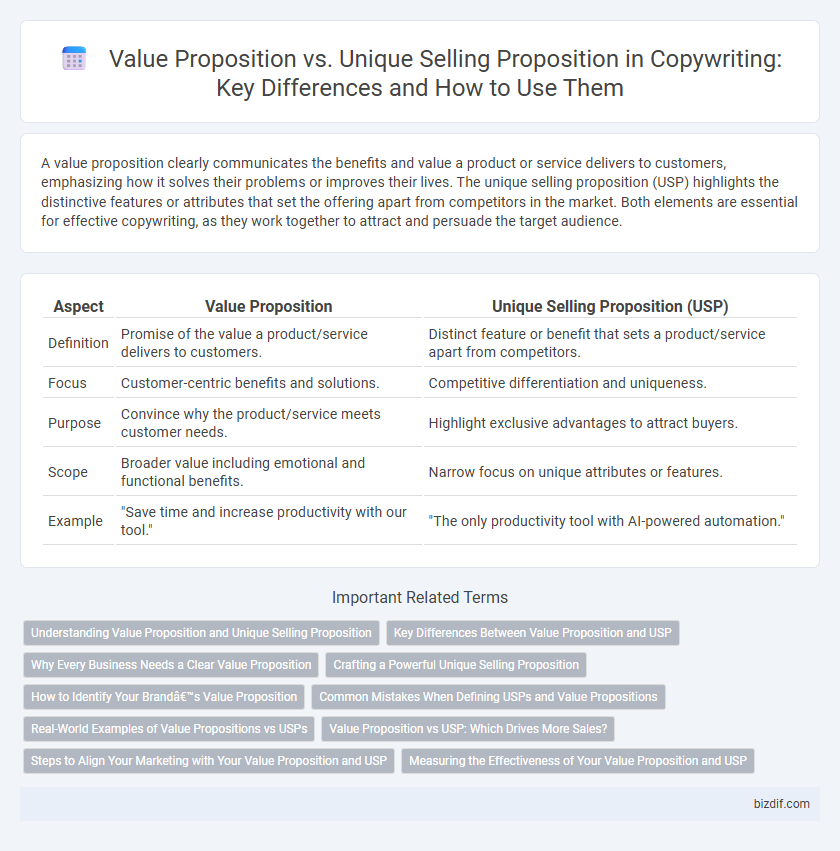A value proposition clearly communicates the benefits and value a product or service delivers to customers, emphasizing how it solves their problems or improves their lives. The unique selling proposition (USP) highlights the distinctive features or attributes that set the offering apart from competitors in the market. Both elements are essential for effective copywriting, as they work together to attract and persuade the target audience.
Table of Comparison
| Aspect | Value Proposition | Unique Selling Proposition (USP) |
|---|---|---|
| Definition | Promise of the value a product/service delivers to customers. | Distinct feature or benefit that sets a product/service apart from competitors. |
| Focus | Customer-centric benefits and solutions. | Competitive differentiation and uniqueness. |
| Purpose | Convince why the product/service meets customer needs. | Highlight exclusive advantages to attract buyers. |
| Scope | Broader value including emotional and functional benefits. | Narrow focus on unique attributes or features. |
| Example | "Save time and increase productivity with our tool." | "The only productivity tool with AI-powered automation." |
Understanding Value Proposition and Unique Selling Proposition
Understanding the difference between a Value Proposition and a Unique Selling Proposition (USP) is crucial in copywriting. A Value Proposition communicates the overall benefits and value a customer gains from a product or service, emphasizing problem-solving and emotional appeal. The USP highlights specific features or attributes that differentiate the product from competitors, focusing on uniqueness and competitive advantage.
Key Differences Between Value Proposition and USP
Value proposition highlights the overall value a product or service delivers to customers, focusing on benefits and solutions that meet their needs. Unique Selling Proposition (USP) emphasizes the distinct feature or advantage that sets a product apart from competitors, often tied to exclusivity or innovation. The key difference lies in value proposition addressing customer perception and problems broadly, while USP targets the specific competitive edge that drives purchase decisions.
Why Every Business Needs a Clear Value Proposition
A clear Value Proposition defines the specific benefits and value a business delivers to its customers, directly addressing their needs and pain points. Unlike a Unique Selling Proposition that highlights what sets the product apart from competitors, the Value Proposition ties customer-centric outcomes to business goals, boosting engagement and conversion rates. Businesses with precise Value Propositions experience higher customer loyalty, improved market positioning, and enhanced communication effectiveness, driving sustained growth.
Crafting a Powerful Unique Selling Proposition
Crafting a powerful Unique Selling Proposition (USP) requires pinpointing the distinct benefit that sets a product or service apart from competitors, emphasizing exclusivity and relevance to the target audience's needs. Unlike a value proposition, which encompasses the overall promise of value delivered, the USP zeroes in on one compelling factor that persuades customers to choose your brand over alternatives. Effective copywriting leverages clear, concise language to highlight this uniqueness, driving higher conversion rates and brand loyalty through targeted messaging.
How to Identify Your Brand’s Value Proposition
Identifying your brand's value proposition involves analyzing the core benefits your product or service offers and understanding how it addresses customer pain points better than competitors. Focus on clear, specific outcomes that resonate emotionally and functionally with your target audience to differentiate your brand in the market. Conduct customer research and competitor analysis to refine a compelling, concise value proposition that drives engagement and conversion.
Common Mistakes When Defining USPs and Value Propositions
Common mistakes when defining USPs and value propositions include confusing features with benefits, leading to vague messaging that fails to resonate with target audiences. Overloading propositions with generic claims dilutes impact and reduces memorability, hindering differentiation from competitors. Neglecting customer-centric language results in propositions that do not address specific pain points or needs, undermining their effectiveness in driving conversions.
Real-World Examples of Value Propositions vs USPs
Value propositions clearly communicate the core benefits and solutions a product offers, exemplified by Slack's promise to "make work simpler, more pleasant, and more productive." Unique selling propositions (USPs) highlight distinct features that set a product apart, such as FedEx's guarantee of "overnight delivery" ensuring reliability and speed. Real-world applications show value propositions appeal to emotional and practical needs, while USPs emphasize competitive differentiation.
Value Proposition vs USP: Which Drives More Sales?
Value Proposition emphasizes the overall benefits and solutions a product offers, aligning closely with customer needs and pain points, which fosters trust and long-term loyalty. Unique Selling Proposition highlights distinct product features that set it apart from competitors, sparking immediate interest and differentiation in saturated markets. Studies show a well-crafted Value Proposition generally drives more sustainable sales growth by creating deeper emotional connections and perceived value beyond superficial differences.
Steps to Align Your Marketing with Your Value Proposition and USP
Identify your target audience's specific needs and pain points to tailor your value proposition and unique selling proposition effectively. Craft clear, compelling messages that highlight the unique benefits and differentiators of your product or service, ensuring consistency across all marketing channels. Continuously test and refine your messaging based on customer feedback and market trends to maintain alignment and maximize engagement.
Measuring the Effectiveness of Your Value Proposition and USP
Measuring the effectiveness of your Value Proposition (VP) and Unique Selling Proposition (USP) involves tracking customer engagement metrics such as conversion rates, click-through rates, and customer retention. Qualitative feedback through surveys and A/B testing reveals how clearly your message resonates with your target audience, while analyzing sales performance data helps determine the direct impact of your propositions on revenue growth. Consistent alignment of VP and USP with customer needs enhances brand differentiation and drives measurable business outcomes.
Value Proposition vs Unique Selling Proposition Infographic

 bizdif.com
bizdif.com